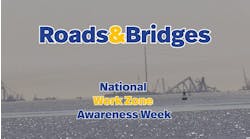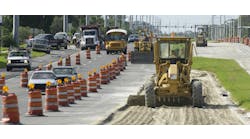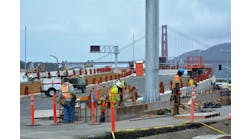By Mark Ludewig, Contributing Author
What is the best time to drive? It’s 3 p.m. on a cloudy day with no precipitation.
That’s the best time because it’s not dark outside and traffic is lighter. Cloudy and without fog so the sun doesn’t get in anyone’s eyes. And zero precipitation so vehicles don’t slip on a wet surface, while visibility isn’t impaired by falling rain or snow.
All other conditions, beware: Of the 6 million vehicular accidents that occur in the U.S. each year, approximately 22% are weather-related, according to the Federal Highway Administration (FHWA).
Tragically, those accidents result in 6,500 deaths and 450,000 injuries.
From intense sun glare to excessive ice to patchy fog, weather challenges drivers in different ways. However, these conditions can pose a greater threat to construction crews working outdoors. Roads and bridge project workers must contend with the elements while remaining vigilant of passing vehicles amidst other hazards.
Be it an interstate highway or winding country road, work sites with barriers, barrels, one-lane traffic and/or active construction vehicles all add up to a zone that requires more driver concentration to navigate. Moreover, adverse weather conditions escalate the risk of accidents.
All-Season Strategies
For construction crew members and those managing traffic flow, there's a strategy for dealing with such conditions.
Durable apparel serves as a foundation. Jackets, boots, shirts, and vests should not only repel precipitation, but also ensure the wearer's comfort. This is crucial as discomfort can distract people from their duties. After all, nobody enjoys rain trickling down their back while directing traffic.
When it comes to vests and jackets, being weather-proof is essential, but being highly visible is equally crucial, especially for those directing traffic. Often, they are just a few feet away from passing vehicles. Therefore, they should always wear fully fluorescent jackets, specifically Class 3 high-visibility style, with reflective stripes that accentuate their movements.
It also is important to correctly utilize clear, sharp signage that remains visible from a distance even in rainy conditions, while effectively reflecting sunlight glare.
While it's ideal to assume that every driver possesses flawless 20/20 vision, the reality is often different. Moreover, even with perfect vision, the words "SLOW" and "STOP" can appear similar on a handheld sign.
Therefore, signage must be clean, sturdy, and visible under any circumstances to eliminate any ambiguity about its message.
In addition to signage, crew members can extend their hands to signal "STOP" or wave to indicate "SLOW." This added movement aids visibility in reduced visibility situations, making every gesture count.
A Technological Assist
Digital tools have proven to be indispensable when enhancing traffic management.
Having integrated artificial intelligence capabilities, scheduling applications enable meticulous planning for optimal worker deployment, all while factoring in prevailing weather data.
Consequently, crews can ensure they have the appropriate apparel and equipment precisely when needed, thus minimizing disruptions.
Moreover, these digital solutions facilitate swift adjustments as weather patterns evolve throughout the day. Crews can seamlessly transition their attire from light rain gear to heavy-duty protection as a sudden shower escalates into a thunderous downpour.
Additionally, regardless of the weather's unpredictability, interconnected tools foster seamless communication among team members.
Despite the persistent challenge of adverse weather, the fusion of traditional best practices and emergent technology can foster a safer construction zone for crews and drivers. This synergy between preparedness and unwavering focus significantly enhances operational safety and efficiency in dynamic construction environments. RB
Mark Ludewig is AWP Safety’s vice president of Safety. AWP Safety plans and coordinates work zone projects requiring the use of sophisticated traffic control devices.



